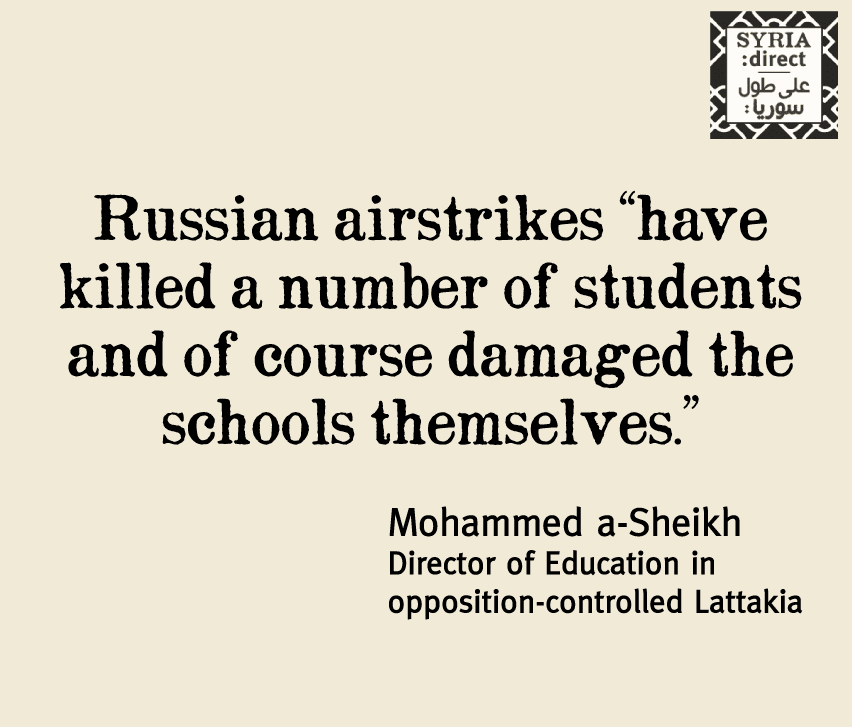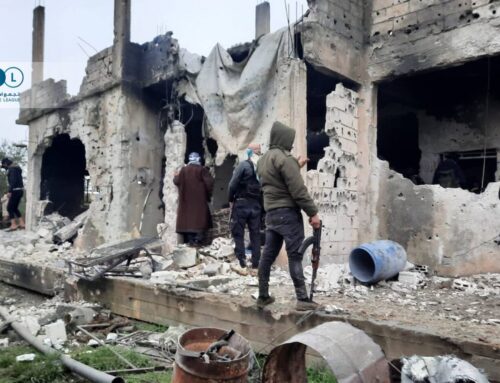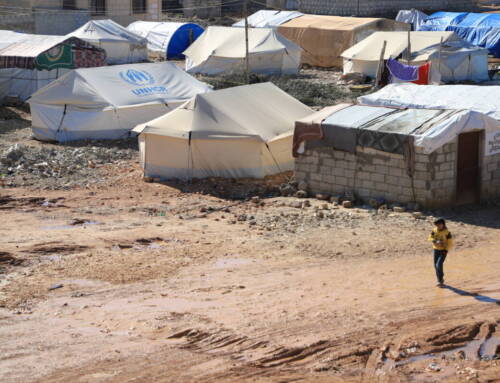Why repeated Russian bombings are causing northern schools to close
Two months of Russian airstrikes in central and northern Syria […]
10 December 2015
Two months of Russian airstrikes in central and northern Syria have paralyzed the education sector in opposition-controlled territory in Homs and Latakia.
The Russian airstrikes, which have killed 254 civilians as of November 2, according to a report by the Syrian Network for Human Rights, are now a part of daily life, with parents too afraid to risk sending their children to school. The local government in the rebel-controlled city of Talbisa, in Homs province, officially cancelled classes in October “until further notice,” citing the danger of the bombings.
Here, two educational professionals in rebel-held areas of Homs and Latakia describe scenes of desolation and desperation.
In the rebel pocket of the northern Homs countryside, where schools are closed, idle children spend their days gathering firewood, says Firas Homsi, who ran a local youth center that closed due to a lack of funding.
With no school to attend, other children support their families by working unskilled jobs.
“Every day on the outskirts of Talbisa, north of Homs, I see a 10-year-old child, Ahmed. He sells 15 to 20 cylinders of gas every day. He doesn’t know how to count. When I bought 10 liters to fill up my car, the total was SP350 [nearly $1] per liter, but he was unable to calculate it.”
Muhammed a-Sheikh, the northern Latakia countryside’s director of education for the opposition-in-exile National Coalition, tells Syria Direct that the Russian bombing campaign has turned Kurdish and Turkmen villages into ghost towns. Residents have fled to the border, with schools sitting empty and shuttered.
“These airstrikes have killed a number of students and of course damaged the schools themselves,” said al-Sheikh. “We are trying to set up schools in the secure areas on the Turkish border to which the people have fled.”
Q: What is the current state of schools and education in the northern Homs countryside?
After the last military campaign in Homs countryside, the school employees fled to Turkey and regime-held areas. Also, due to Russian air strikes, no one is sending their children to school.
Q: How do children spend their days now that the schools are closed?
They spend their days collecting firewood and helping their families obtain daily sustenance.
Every day on the outskirts of Talbisa, north of Homs, I see a 10-year-old child, Ahmed, he sells 15 to 20 cylinders of gas every day. He doesn’t know how to count. When I bought 10 liters to fill up my car, it was SP350 [nearly $1] per liter, but he was unable to calculate it.
This is the situation for most of the children in Homs’s northern countryside and the children in Syria in general.
Q: Talk about the educational club you formed and what happened to it.
The main challenge was the lack of material resources. For example, we needed a generator, a projector and writing materials. The amount we had wasn’t more than $600. With this money we were able to secure some of the students’ needs such as shoes, as most didn’t have any. We were also able to secure a location and pay for a blackboard. However, a few months after opening, support vanished and we were unable to secure the needed materials and the program stopped.
Q: How did the children react to the opening of the club? Conversely, how did they react to its closing?
The children would arrive an hour before classes started. We created a great environment for them. We transformed their classes into a fun learning experience. Unfortunately, this didn’t last long. When the center closed the children were visibly saddened. When the situation improves, we will reopen and start over.
Muhammed al-Sheikh, the northern Latakia countryside’s director of education for the opposition-in-exile National Coalition
Q: How many schools have been closed? Why are these schools being closed?
In Jabal Akrad, 11 schools have been closed, while in Jabal Turkman four schools have been closed. The main reason for their closures has been Russian cluster bomb strikes on Kurdish and Turkmen villages. This has caused a large wave of people to flee these villages and head to the Turkish border in search of security. These airstrikes have killed a number of students and of course damaged the schools themselves. There are now tens of empty schools and hundreds of empty homes.
How many students have been affected by the school closures? How long have they been cut off from their studies?
These schools served approximately 3,000 students in Jabal Akrad and 1,000 students in Jabal Turkman. These students have been without an education for about a month. This will not deter us. After we were sure Russian planes were targeting our schools, we needed to protect the students and teachers. Russian planes target no one but civilians.
Q: What measures are being taken deal with the issue?
We are currently coming up with alternative measures and plans. We are trying to bring these schools to secure areas on the Turkish border which are near the internally displaced Syrians. We are attempting to increase the number of schools for these students. However, this isn’t enough. There are a large number of internally displaced. We need more large tents, and paved ground because of the problems rain causes.







